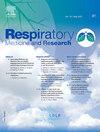内镜下肺减容后的胸部力学:基于动态恶性膨胀的反应者和无反应者的比较
IF 1.8
4区 医学
Q3 RESPIRATORY SYSTEM
引用次数: 0
摘要
研究背景:在严重肺气肿病例中,支气管肺减容术(ELVR)可改善肺功能、运动能力和生活质量。然而,并不是所有的患者都能通过ELVR得到改善,包括那些肺容量明显减少的患者。我们测试了单侧体积损失对反应者和非反应者的影响不同的假设。方法对20例患者进行回顾性分析,根据同期吸气量增加≥200 ml分为有反应13例和无反应7例。我们比较了ELVR前后三个月肺容量、膈形状和力量、纵隔移位、肺功能、运动能力和生活质量的变化。结果与无反应者相比,反应者的膈肌强度(4比2 cmH2O, p = 0.0318)和两侧形状(未治疗侧总面积:+42 (7-54)cm2, p = 0.0079,未治疗侧相邻区:+26 (18-52)cm2, p = 0.0270)有更大的改善。有反应者的纵隔移位比无反应者大(13度vs. 3度,p = 0.0039),纵隔移位与肺功能(FEV1: r = 0.48, p = 0.0365)、运动能力(6MWD: r = 0.78, p <;0.0001,吸气量:r= 0.48, p = 0.0365)和生活质量(CAT: r=-0.58, p = 0.0096)。结论动态恶性通货膨胀反应者的纵隔移位比无反应者大。这种转变可能是改善隔膜形状和强度的标志,在处理和未处理的两侧。临床试验注册编号:nct05799352本文章由计算机程序翻译,如有差异,请以英文原文为准。
Chest mechanics after endoscopic lung volume reduction: Comparison between responders and non-responders based on dynamic hyperinflation
Background
Endobronchial lung volume reduction (ELVR) improves lung function, exercise capacity, and quality of life in case of severe emphysema. Nevertheless, not all patients are improved by ELVR including those with substantially decreased lung volume. We tested the hypothesis that unilateral volume loss could impact differently both responders and non-responders.
Methods
A retrospective analysis was performed on 20 patients, classified as 13 responders and 7 non-responders based on inspiratory capacity increase ≥200 ml at isotime. We compared changes in lung volume, diaphragm shape and strength, mediastinal shift, lung function, exercise capacity, and quality of life before and three months after ELVR.
Results
Compared to non-responders, responders showed a more improved diaphragm strength (4 vs. 2 cmH2O, p = 0.0318) and shape in both sides (non-treated side total area: +42 (7–54) cm2, p = 0.0079, non-treated side zone of apposition: +26 (18–52) cm2, p = 0.0270). Responders had a larger mediastinal shift than non-responders (13 vs. 3 degrees, p = 0.0039) with significant positive correlations between mediastinal shift and improvements in lung function (FEV1: r = 0.48, p = 0.0365), exercise capacity (6MWD: r = 0.78, p < 0.0001, inspiratory capacity: r = 0.48, p = 0.0365), and quality of life (CAT: r=-0.58, p = 0.0096).
Conclusions
Dynamic hyperinflation responders present a larger mediastinal shift than non-responders. This shift could be a marker of improved diaphragm shape and strength in both treated and non-treated sides.
Clinical trial registration
NCT05799352
求助全文
通过发布文献求助,成功后即可免费获取论文全文。
去求助
来源期刊

Respiratory Medicine and Research
RESPIRATORY SYSTEM-
CiteScore
2.70
自引率
0.00%
发文量
82
审稿时长
50 days
 求助内容:
求助内容: 应助结果提醒方式:
应助结果提醒方式:


